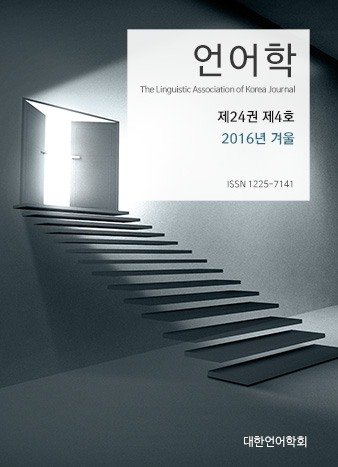대한언어학회 전자저널

-
An Alternative Approach to Realizations of the Medial [nt] Cluster in English
-
Boundary and pitch effects on the perception of Korean alveolar nasal
-
Corpus-Based English Grammar Instruction in a Korean College Context Korean College Context
-
A Study on the Relationship between Self-Efficacy Beliefs and Comprehension in English Reading
Abstract
Keywords
# 음운이웃 # 최소대립쌍 # 한국어 폐쇄음 # VOT # F0 # H1-H2.
References
- 강범모, 김흥규. (2004). 한국어 형태소 및 어휘 사용 빈도의 분석 2: 550만 어절의 세종 형태의미분석 말뭉치를 기반으로. 컴퓨터와 인문학 시리즈 10. 서울: 고려대학교 민족문화연구원.
- 권유안, 조혜숙, 김충명, 남기춘. (2006). 한국어 시각단어재인에서 나타나는 이웃효과. 말소리, 60, 29-45.
- 권유안, 남기춘. (2011). 한글 음절 이웃 효과에서 한자어 형태소의 영향: 표기 및 음운 이웃과 한자어 이웃과의 관련성을 중심으로. 한국심리학회지:인지 및 생물, 23, 301-319.
- 김미령. (2015). 한국어-영어 이중 언어 화자들의 L1과 L2 영향에 관한 연구: VOT와 F0 관련해서. 말소리와 음성과학, 7, 13-26.
- Baese-Berke, M., & Goldrick, M. (2009). Mechanisms of interaction in speech production. Language and Cognitive Process, 24, 527-554.
- Bang, H., Sonderegger, M., Kang, Y., Clayardsa, M., & Yoon. T. (2015). The effect of word frequency on the timecourse of tonogenesis in Seoul Korean. Proceedings of the International Congress of Phonetic Sciences, Glasgow, UK.
- Bates, D., Maechler, M., Bolker and Walker, S. (2015). lme4: Linear mixed-effects models using S4 classes. R package version 1.1-9. Available at http://CRAN.R-project.org/package=lme4 (Last viewed October 2, 2015).
- Boersma, P., & Weenink, D. (2014). Praat: doing phonetics by computer [Computer program], version 5.4.12. Available at http://www.praat.org (Last viewed July 10, 2015).
- Buz, E., Tanenhaus, M., & Jaeger, F. (2016). Dynamically adapted context-specific hyper-articulation: Feedback from interlocutors affects speakers’ subsequent pronunciations. Journal of Memory and Language, 89, 68-86.
- Choi, Y., & Choi, M. (2016). Infant’s speech perception research: A literature review and an outlook for related Korean studies. Communication Sciences and Disorders, 21, 1-14.
- Cho, T., Jun, S.-A,, & Ladefoged, P. (2002). Acoustic and aerodynamic correlates of Korean stops and fricatives. Journal of Phonetics, 30, 193-228.
- Cho, T., Lee, Y., & Kim, S. (2011). Communicatively driven versus prosodically driven hyper-articulation in Korean. Journal of Phonetics, 39, 344-361.
- Dell, G. (1986). A spreading-activation theory of retrieval in sentence production. Psychological Review, 93, 283-321.
- Goldrick, M. (2006). Limited interaction in speech production: Chronometric, speech error and neuropsychological evidence. Language and Cognitive Processes, 21, 817-855.
- Goldinger, S., & Summers W. (1989). Primining lexical neighbors of spoken words: Effects of competition and inhibition. Journal of Memory and Language, 28, 501-518.
- Kang, K.-H., & Guion, S. (2008). Clear speech production of Korean stops: Changing phonetic targets and enhancement strategies. The Journal of the Acoustical Society of America, 124, 3909-3917.
- Kang, Y. (2014). Voice onset time merger and development of tonal contrast in Seoul Korean stops: a corpus study. Journal of Phonetics, 45, 76-90.
- Kim, M.-R., Beddor, P., & Horrocks, J. (2002). The contribution of consonantal and vocalic information to the perception of Korean initial stops. Journal of Phonetics, 30, 77-100.
- Kim, M.-R. (2014). Ongoing sound change in the stop system of Korean: A three- to two-way categorization. Studies in Phonetics, Phonology, and Morphology, 20, 51-82.
- Kirov, C., & Wilson, C. (2012). The specificity of online variation in speech production. In Proceedings of the 34th annual conference of the cognitive science society, 587-592.
- Kong, E., & Lee, H. (2016). Attentional modulation and individual differences in explaining the changing role of F0 in the Korean laryngeal stop perception. Paper presented at the 15th conference on laboratory phonology, Itacha, NY, 13-17 July.
- Oh, E. (2011). Effects of speaker gender on voice onset time in Korean stops. Journal of Phonetics, 39, 59-67.
- Oh, M., & Yang, H. (2013). The production of stops by Seoul and Yanbian Korean speakers. Journal of the Korean Society of Speech Sciences, 5, 185-193.
- R Development Core Team. (2015). R: A language and environment for statistical computing. R Foundation for Statistical Computing, Vienna, Austria. Available at https://www.R-project.org/ (Last viewed October 2, 2015).
- Pate, J., & Goldwater, S. (2015). Talkers account for listener and channel characteristics to communicate efficiently. Journal of Memory and Language, 78, 1-17.
- Schertz, J. (2013). Exaggeration of featural contrasts in clarifications of misheard speech in English. Journal of Phonetics, 41, 249-263.
- Silva, D. (2006). Acoustic evidence for the emergence of tonal contrast in contemporary Korean. Phonology, 23, 287-308.
- Uther, M., Knoll, M., & Burnham, D. (2007). Do you speak E-NG-L-I-SH? A comparison of foreigner- and infant-directed speech. Speech Communication, 49, 2-7.